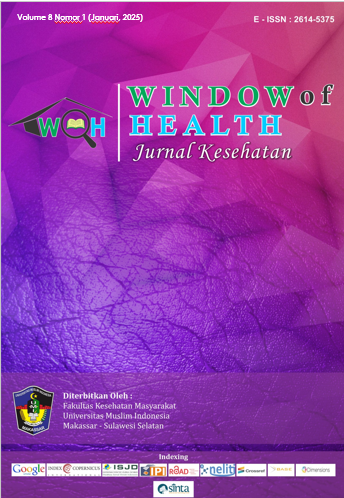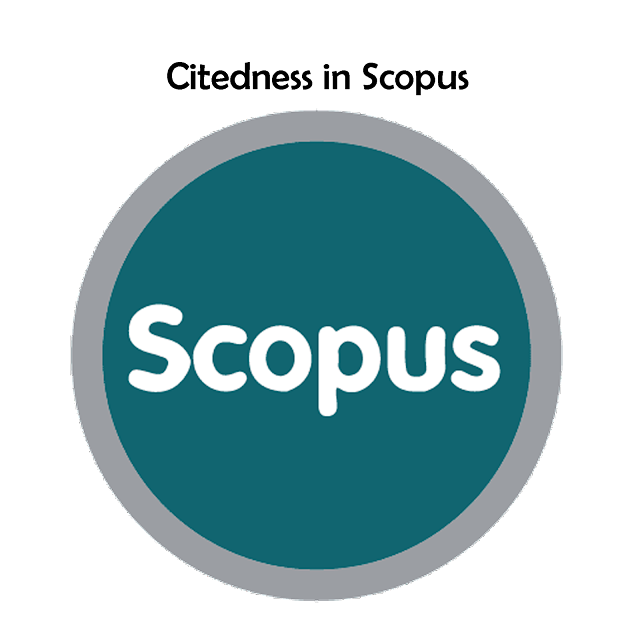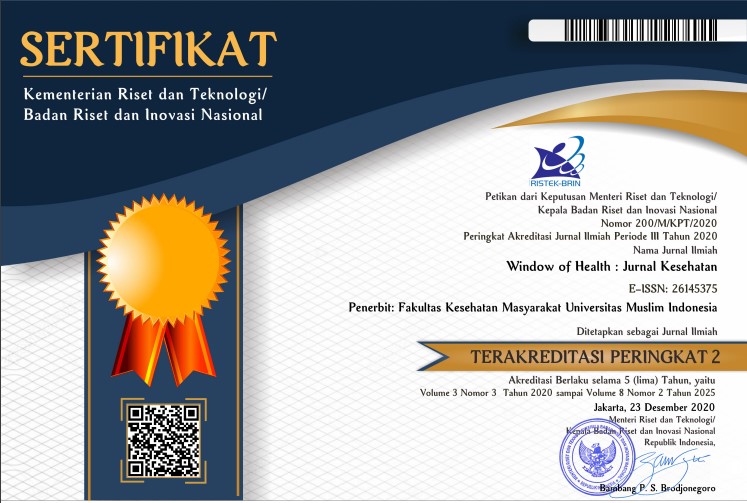Microplastics Depuration Using Seawater In Asiatic Hard Clams (Meretrix) In The Waters Of The Jenelata River, Gowa
Abstract
Depuration is an effort to reduce/eliminate contamination, including microplastics, using a water circulation system. This study aims to determine the effective depuration time to reduce the microplastic content in Asiatic hard clams (Meretrix). This study used a quantitative approach with an experimental research design and a completely randomized design. There are 450 clams used as an experimental animal where the treatment consisted of four depuration times, namely 1, 2, 3, and 4 days with three repetitions of each treatment, while the control clams were without depuration. Analysis of variance (ANOVA) was used to see the effect of depuration treatment on the microplastic content. If the effect of the treatment was significantly different, then the Post Hoc Test was continued to determine the differences between treatments. The results showed that Asiatic hard clams (Meretrix) obtained from the mouth of the Jenelata River, Gowa, were contaminated with microplastics ranging from 0.6 to 8.1 MPs/clam and an average of 3.96 MPs/clam. Depuration time significantly affected the microplastic content in clams' depuration effectiveness. There is a tendency for a longer depuration time to decrease microplastic content in clams. The adequate depuration time to reduce the microplastic content in Asiatic hard clams (Meretrix) was 3 and 4 days. Based on the findings of this study, it is recommended that further research be conducted to explore methods for reducing microplastics using natural materials.
References
E. L. Ng et al., “An overview of microplastic and nanoplastic pollution in agroecosystems,” Science of the Total Environment. 2018, doi: 10.1016/j.scitotenv.2018.01.341.
S. A. Mason, V. G. Welch, and J. Neratko, “Synthetic Polymer Contamination in Bottled Water,” Front. Chem., vol. 6, pp. 1–17, 2018, doi: 10.3389/fchem.2018.00407.
M. Kedzierski et al., “Threat of plastic ageing in marine environment. Adsorption/desorption of micropollutants,” Mar. Pollut. Bull., vol. 127, no. July 2017, pp. 684–694, 2018, doi: 10.1016/j.marpolbul.2017.12.059.
B. Henry, K. Laitala, and I. G. Klepp, Microplastic pollution from textiles : a literature review, no. 1. 2018.
A. A. Horton, M. D. Jürgens, E. Lahive, P. M. van Bodegom, and M. G. Vijver, “The influence of exposure and physiology on microplastic ingestion by the freshwater fish Rutilus rutilus (roach) in the River Thames, UK,” Environ. Pollut., 2018, doi: 10.1016/j.envpol.2018.01.044.
E. Guzzetti, A. Sureda, S. Tejada, and C. Faggio, “Microplastic in marine organism: Environmental and toxicological effects,” Environmental Toxicology and Pharmacology. 2018, doi: 10.1016/j.etap.2018.10.009.
M. C. Rillig, A. Lehmann, A. A. de Souza Machado, and G. Yang, “Microplastic effects on plants,” New Phytologist. 2019, doi: 10.1111/nph.15794.
T. Byers, M. Mahat, K. Liu, A. Knock, and W. Imms, “A systematic review of the effects of learning environments on student learning outcomes. Techical report.,” Learn. Univ. Melb., vol. 1, no. 2, pp. 1–45, 2018.
A. Grimani, E. Aboagye, and L. Kwak, “The effectiveness of workplace nutrition and physical activity interventions in improving productivity, work performance and workability: A systematic review,” BMC Public Health, vol. 19, no. 1, pp. 1–12, 2019, doi: 10.1186/s12889-019-8033-1.
P. Yu, Z. Liu, D. Wu, M. Chen, W. Lv, and Y. Zhao, “Accumulation of polystyrene microplastics in juvenile Eriocheir sinensis and oxidative stress effects in the liver,” Aquat. Toxicol., 2018, doi: 10.1016/j.aquatox.2018.04.015.
S. Franzellitti, L. Canesi, M. Auguste, R. H. G. R. Wathsala, and E. Fabbri, “Microplastic exposure and effects in aquatic organisms: A physiological perspective,” Environmental Toxicology and Pharmacology. 2019, doi: 10.1016/j.etap.2019.03.009.
Z. L. R. Botterell, N. Beaumont, T. Dorrington, M. Steinke, R. C. Thompson, and P. K. Lindeque, “Bioavailability and effects of microplastics on marine zooplankton: A review,” Environmental Pollution. 2019, doi: 10.1016/j.envpol.2018.10.065.
J. Li et al., “Using mussel as a global bioindicator of coastal microplastic pollution,” Environmental Pollution. 2019, doi: 10.1016/j.envpol.2018.10.032.
J. P. G. L. Frias, V. Otero, and P. Sobral, “Evidence of microplastics in samples of zooplankton from Portuguese coastal waters,” Mar. Environ. Res., 2014, doi: 10.1016/j.marenvres.2014.01.001.
C. Alomar and S. Deudero, “Evidence of microplastic ingestion in the shark Galeus melastomus Rafinesque, 1810 in the continental shelf off the western Mediterranean Sea,” Environ. Pollut., vol. 223, pp. 223–229, 2017, doi: 10.1016/j.envpol.2017.01.015.
S. Serranti, R. Palmieri, G. Bonifazi, and A. Cózar, “Characterization of microplastic litter from oceans by an innovative approach based on hyperspectral imaging,” Waste Manag., 2018, doi: 10.1016/j.wasman.2018.03.003.
G. Ašmonaitė and B. C. Almroth, “Effects of Microplastics on Organisms and Impacts on the Environment : Balancing the Known and Unknown,” no. February, pp. 1–71, 2019, doi: 10.13140/RG.2.2.28556.77448.
A. L. Lusher, N. A. Welden, P. Sobral, and M. Cole, “Sampling, isolating and identifying microplastics ingested by fish and invertebrates,” Analytical Methods. 2017, doi: 10.1039/c6ay02415g.
P. E. Redondo-Hasselerharm, D. Falahudin, E. T. H. M. Peeters, and A. A. Koelmans, “Microplastic Effect Thresholds for Freshwater Benthic Macroinvertebrates,” Environ. Sci. Technol., 2018, doi: 10.1021/acs.est.7b05367.
S. Birnstiel, A. Soares-Gomes, and B. A. P. da Gama, “Depuration reduces microplastic content in wild and farmed mussels,” Mar. Pollut. Bull., vol. 140, no. January, pp. 241–247, 2019, doi: 10.1016/j.marpolbul.2019.01.044.
D. Lees, A. Science, A. Younger, and A. Science, Depuration and relaying, no. January 2010. 2019.
C. Hannon, “Efficacy of microplastic depuration on two commercial oyster species from the west coast of Ireland,” no. May, 2023, doi: 10.1111/jwas.12989.
Un Nutrion, “The role of aquatic foods in sustainable healthy diet,” in Discussion Paper, Un Nutrion, 2021, pp. 1–64.
M. R. Cordova, A. I. S. Purwiyanto, and Y. Suteja, “Abundance and characteristics of microplastics in the northern coastal waters of Surabaya, Indonesia,” Mar. Pollut. Bull., 2019, doi: 10.1016/j.marpolbul.2019.03.040.
M. Kedzierski, M. Falcou-Préfol, M. E. Kerros, M. Henry, M. L. Pedrotti, and S. Bruzaud, “A machine learning algorithm for high throughput identification of FTIR spectra: Application on microplastics collected in the Mediterranean Sea,” Chemosphere, vol. 234, no. November, pp. 242–251, 2019, doi: 10.1016/j.chemosphere.2019.05.113.
M. Sighicelli et al., “Microplastic pollution in the surface waters of Italian Subalpine Lakes,” Environ. Pollut., 2018, doi: 10.1016/j.envpol.2018.02.008.
N. Digka, C. Tsangaris, M. Torre, A. Anastasopoulou, and C. Zeri, “Microplastics in mussels and fish from the Northern Ionian Sea,” Mar. Pollut. Bull., 2018, doi: 10.1016/j.marpolbul.2018.06.063.
T. de S. e. S. Pegado et al., “First evidence of microplastic ingestion by fishes from the Amazon River estuary,” Mar. Pollut. Bull., 2018, doi: 10.1016/j.marpolbul.2018.06.035.
W. Tubagus, Sunarto, M. R. Ismail, and L. P. S. Yuliadi, “Identification of microplastic composition on clams (Gafrarium tumidum) and sediments in Pari Island, Seribu Islands, Jakarta,” Ilmu Kelaut. Indones. J. Mar. Sci., vol. 25, no. 3, pp. 115–120, 2020, doi: 10.14710/ik.ijms.25.3.115-120.
Copyright (c) 2025 Yuliati

This work is licensed under a Creative Commons Attribution-NonCommercial-ShareAlike 4.0 International License.








